Dell XPS 15 L502x: Now with Sandy Bridge
by Jarred Walton on April 20, 2011 1:10 AM ESTBetter Midrange Graphics, But Still Midrange
If you just look at the model number, you might get the idea that the GeForce GT 540M is a significant upgrade from the other GT 420M found in the original XPS 15. Unfortunately, that’s the problem with model numbers; the reality is the only key differences are in clock speeds (and power requirements). Both the GT 420M and the GT 540M sport the same 96 CUDA cores and a 128-bit DDR3 memory interface; however, the GT 420M comes clocked at 500/1000MHz on the core/shaders while the GT 540M sports a 672/1344MHz clock. The memory also runs at 900MHz instead of 800MHz. The result is up to 34% faster computational performance but only 12.5% more memory bandwidth. That means in practice the L502x should beat the L501x by 10 to 35% in gaming performance, depending on where the bottleneck happens to lie—though it could be higher on games that depend more on the CPU.
Here are the full results at our low, medium, and high default settings. Twenty-four graphs for your viewing pleasure; please, take your time.
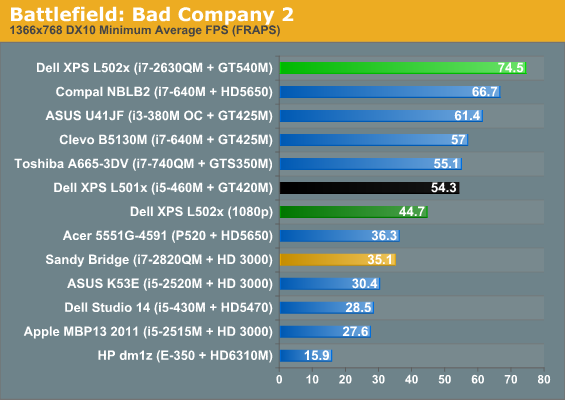

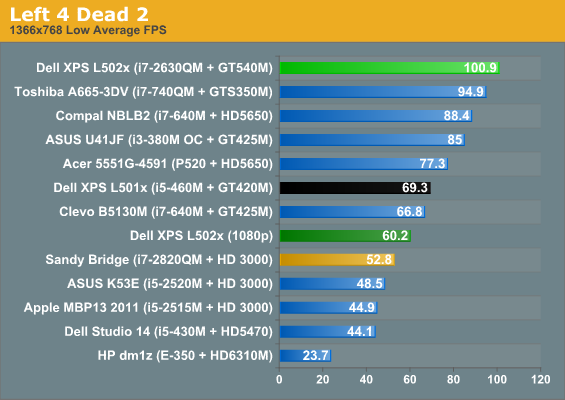
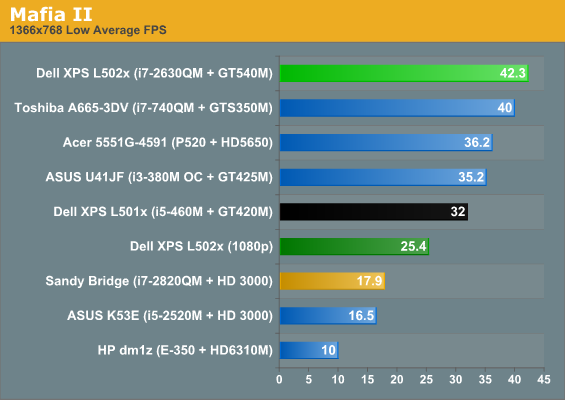
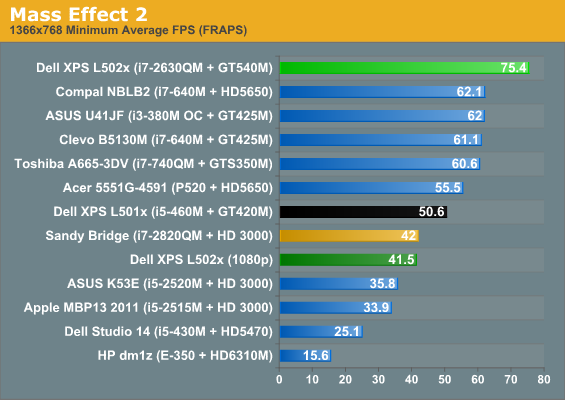
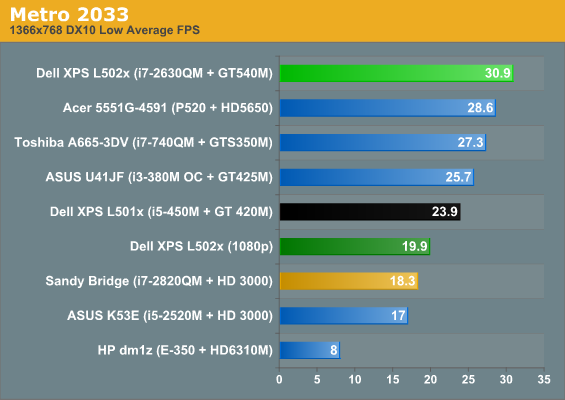
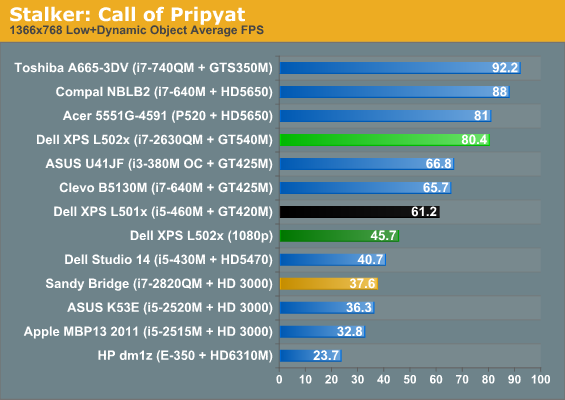
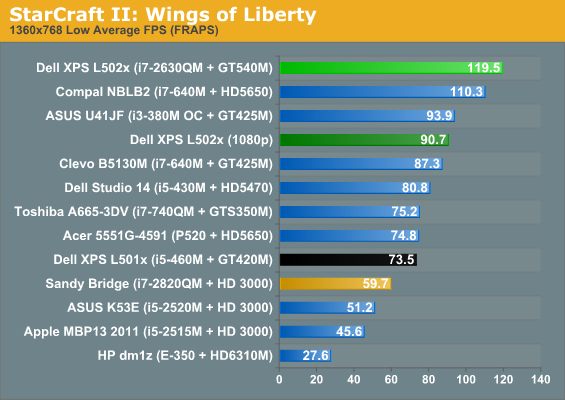

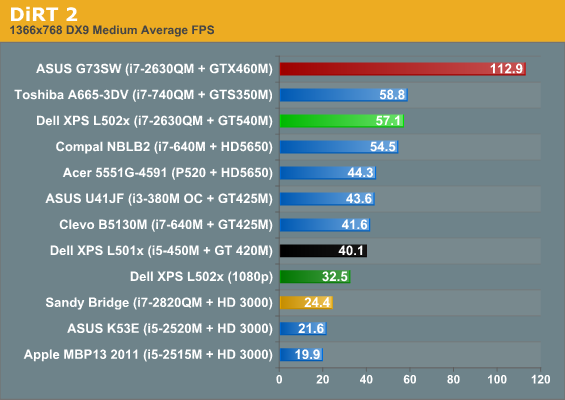
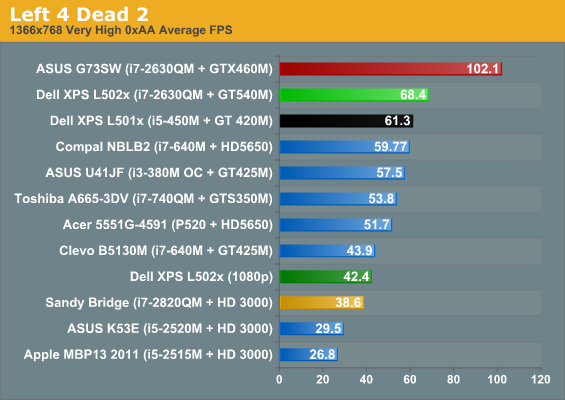
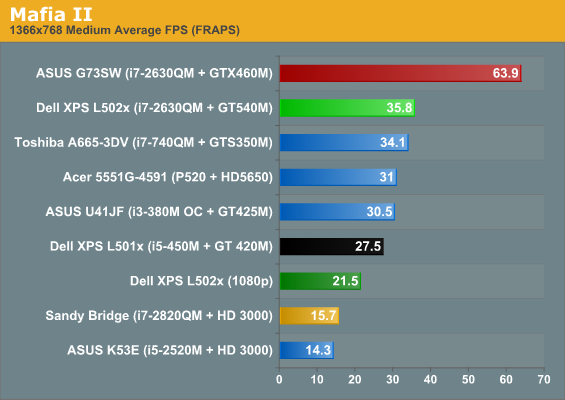
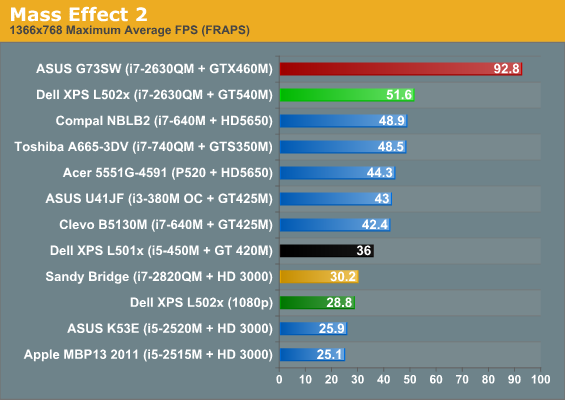
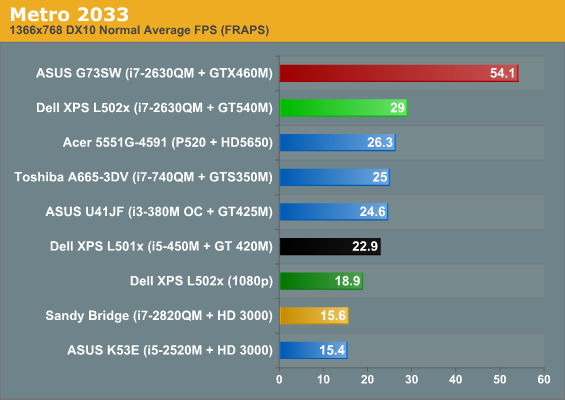
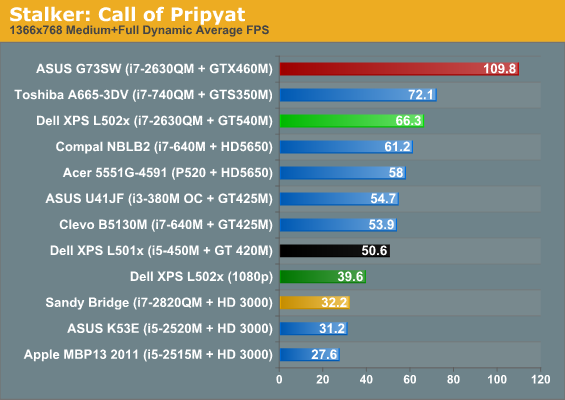
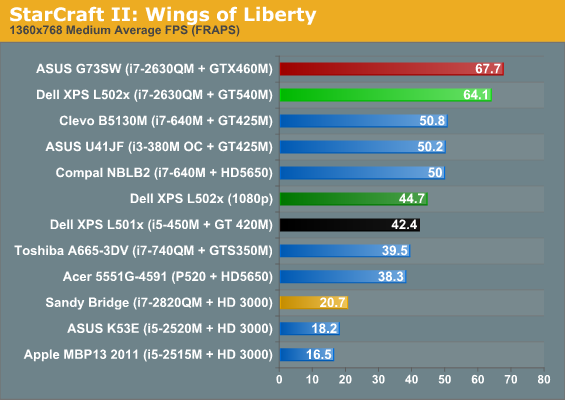
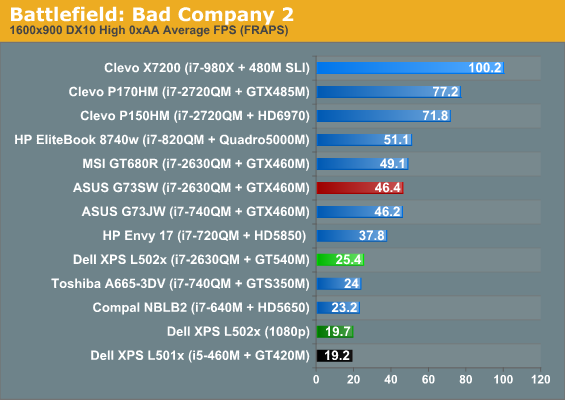
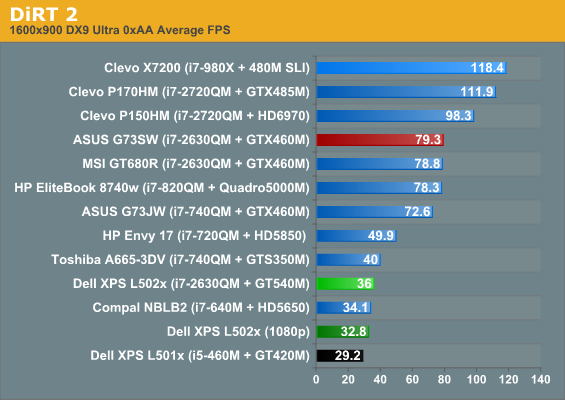

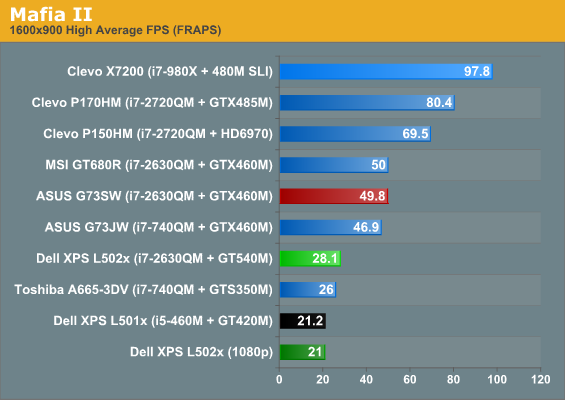

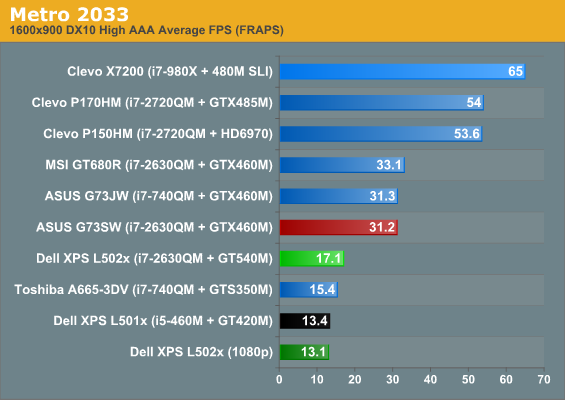
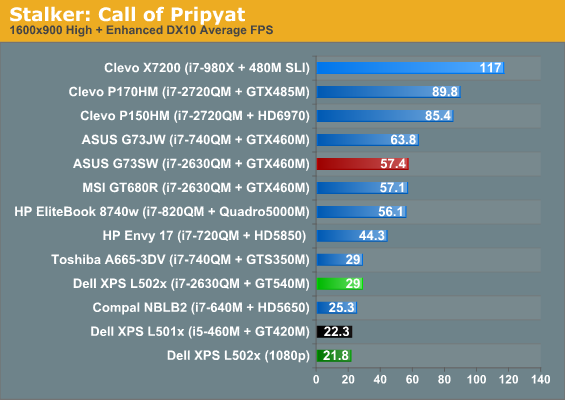
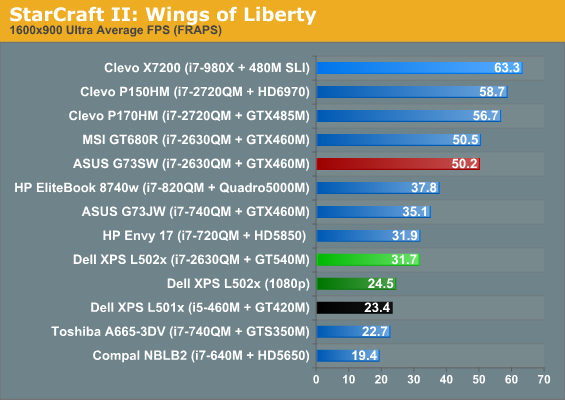
Looking at the charts and comparing the L501x with the L502x, the CPU actually appears to be a significant bottleneck at lower quality settings. That starts to go away once we move to medium quality and is largely gone at high quality, and there’s still the question of driver differences. The L502x is 31 to 63% faster than the L501x at our low settings, 12 to 51% faster at medium, and 23-43% faster at high. In general, the L502x is able to handle low to medium detail at the native 1080p resolution; if you want to run at medium to high settings you’ll often have to lower the resolution.
Going back to the ASUS G73SW (GTX 460M) comparison once more, we don’t have results for at low quality on the 460M, but the gap at medium is 6 to 198%—with the small 6% lead coming in StarCraft II, a game that can be extremely CPU limited at lower detail settings. If we remove SC2 from the list, the lead is 49 to 98%, which is more in line with what you’d expect from the GPU differences. At high detail, the lead grows to 58 to 120%—again with SC2 being the smallest difference, though L4D2 is similar in that it’s only a 60% lead for the 460M. So how does a GPU that’s got twice the computational performance and slightly more than double the bandwidth end up 120% faster in some games? The 540M in the XPS 15 comes with 2GB RAM versus 1.5GB in the G73SW, so that’s not the explanation. The likely culprit is Optimus, which can have a bit of a PCIe bandwidth bottleneck at times, though it’s possible there’s just something peculiar in how DiRT 2 does things.
If you’re after a good all-around laptop that can handle most games, the new XPS 15 improves on the old model but it’s often not a big enough change to allow you to run at native resolution with higher quality settings. What it does provide is a smoother experience at reasonable settings. The L501x could hit 30 FPS at 1080p and medium detail in three of our eight test games and the L502x breaks 30FPS with the same settings in five games (Mafia II, Mass Effect 2, and Metro 2033 being the exceptions). At our 900p High defaults, the L501x couldn’t break 30FPS in any of the games, but the L502x gets half the games (DiRT 2, Left 4 Dead 2, Mass Effect 2, and STALKER) above our “minimum desired performance” threshold. Dedicated laptop gamers however will still want more.
We’re still waiting to see where the GT 555M falls in terms of performance, but it should slot in nicely between the 540M and the significantly faster GTX offerings. All of the 540M and lower GPUs get saddled with the same 128-bit memory interface, and without GDDR5 to increase bandwidth there’s a significant bottleneck when you start increasing resolution. GDDR5 unfortunately is power hungry, so for the time being most mobile GPUs are saving it for their high-end SKUs where battery life isn’t a concern. Outside of the GTX line, the GT 555M is one of the few NVIDIA mobile GPUs where you can find GDDR5—and there’s some weird changes in the core and memory interfaces for the two 555M models.
The GT 555M version with GDDR5 uses a 128-bit bus and comes with the same 96 CUDA cores as the 540M, but they’re clocked 12% higher. That means you get 12% more computational performance but 74% more bandwidth compared to the GPU in our L502x. The 192-bit DDR3 version of the 555M has slightly less bandwidth, but it has 144 CUDA cores and accounting for clock speeds it has 17.5% more computational performance than the GDDR5 model—and 32% more computational performance than the 540M. It has less bandwidth than the GDDR5 model, even with a 192-bit memory interface, but still 50% more than the 540M. It looks like the new Alienware M14x will use the 192-bit DDR3 version of the GT 555M, which means gaming performance should be around 40-50% faster than the XPS L502x, and coupled with a 900p LCD upgrade the GT 555M should be just about right for our “High” gaming settings.










76 Comments
View All Comments
JanusSoCal - Thursday, April 21, 2011 - link
I second everybody who has left comments to say that this is probably the most thorough and detailed review I've read of the XPS 15 so far. But I was curious about three things. First, you didn't mention what you thought of their new island-keyboard design, which I thought was a pretty big change from the 1st gen. Did you find the typing experience and build better with the 1st gen. keyboard or 2nd gen. keyboard? Also, you mentioned that the frame is solid but the top is plastic... I was wondering if that meant the build quality is good or not good, since the frame is supposedly made of magnesium alloy. So, is all that marketing about how the top cover and palm rests are made out of anondized aluminum for a sturdier build is just mere marketing? Is it literally like a very thin coat of aluminum over cheap plastic? And finally, I guess since you gave the Gold Editor's Choice to the 1st Gen XPS 15, did you consider the 2nd Gen XPS 15, against the current crop of laptops more of a silver, bronze, copper?Again, thanks for writing an excellent review, I've been waiting for Anandtech's take on the 2nd gen. XPS 15 for a long time.
JarredWalton - Thursday, April 21, 2011 - link
Ha! I knew something was wrong and I just couldn't put my finger on it, so to speak. I kept thinking, "this doesn't feel as solid as I recall from the first XPS 15," but I figured it was the same. Given the number of laptops I see, sometimes things get a bit fuzzy in my mind so I figured it was still fine. Now that you point it out, the keyboard definitely changed, and IMO it's not for the better. The palm rest on the L502x is also definitely made of plastic, where I believe (but am not certain) the previous model was anodized aluminum. In both cases, the change is a downgrade as far as I'm concerned.I've gone and updated the second page to discuss this a bit more. Ultimately, it's still a good consumer notebook, but it's not without flaws. The previous garnered a Gold by being one of the first laptops in a long time to give us good build quality, a great screen, awesome speakers, and decent all around performance for a moderate price of $1000. The L502x carries forward most of those aspects, but I'd actually downgrade it to a Silver this time around (or an honorable mention without the 1080p LCD upgrade).
will2 - Thursday, April 21, 2011 - link
@jaredwalton. Would appreciate any feedback on my post on above - last post of yesterday, re. if you plan to review the Latitude E6520, and from anyone also, their thoughts on ideal screen size/resolution combinations for photo-editing, film viewing and general business useJarredWalton - Thursday, April 21, 2011 - link
Responded above... sorry I missed it before. :-)will2 - Saturday, April 23, 2011 - link
Many thanks for your views on screen sizes/resolution combinations which seems to support my thinking that after working on a 14" 1440x900 for last 4 years, a change to 15" 1600x900 will maintain my work surface but reduce eye-strain a little.re. "With that in mind, I hope Anandtech can review the SNB Latitude E6520 with 1600x900 screen. Is that likely soon ?" any input on that ?
Re. another posters question, I was thinking the 2520M a good choice of CPU when limited to a 35W TDP series, although I would have preferred a 25W TDP for reduced temperatures, yet giving sufficient performance.
Re. other postings on selection of best SSD, if choosing the Latitude E6520, I was thinking to retain the HDD for data only, and take advantage of new SSD performance by adding a small internal PCIe or ExpressCard SSD to hold and boot the Windows 7 + Apps, as it has no mSATA slot. However, there seem to be few mainstream makers of miniPCIe or ExpressCard SSDs - and those I have seen, at 50 to 100MB/s Sequential Read max, are a long way short of the mSATA Intel 310 200MB/s performance - yet no cheaper ! Do you have any links to good advice on choosing small form factor SSDs for Notebook internal slots ?
Thanks again for your views on screen sizes/resolutions
cookiezulu - Friday, April 22, 2011 - link
I purchased this (LX502) and expected to have it delivered on Tuesday. (1080p, i7-2720, 8GB, 7 Ultimate)I live in the UK so at the time of buying I could only choose the 500 or 750 SATA HDD. I chose the 500 as I thought I was going to replace it with an SSD - I've been convinced by all the reviews here & elsewhere that the difference in speed/performance with an SSD is noticeable. However I'm struggling to decide (from reading the reviews) whether a 256GB Crucial c300 is the best available at the moment for this laptop in the UK. Best in terms of price / performance.
Or should I wait another 2-3 months for some other, greater, better SSD? I've not followed the SSD market in depth so I'm just checking that we're not waiting for some big improvement any day now (and I get caught out buying the c300 now.
Am I right in understanding that even for the same model (C300) the 256GB is faster than the 128GB one?
Also, does anybody know what the SATA controller is in LX502?
Thanks,
Cookie
JarredWalton - Friday, April 22, 2011 - link
The L502x should have both 6Gbps and 3Gbps SATA ports from the HM65 chipset, and presumably the HDD/SSD would use the 6Gbps ports. As such, you can definitely get better performance from the latest 6.0Gbps capable SSDs.The king of the hill right now is the SandForce SF-2200 controller, but the C400 and Intel 510 are both reasonable alternatives. It's really going to come down to pricing. For a 240/256GB SSD, I would probably go for the OCZ Vertex 3. It'll run around $530, give or take, and I have no idea what the UK prices will be, but that's likely the fastest SSD we'll see in the next 8 months.
Regarding size and performance, it depends in part on the process technology for the NAND. 34nm NAND you usually get optimal performance at 120/128GB, and maybe a little bit faster at 240/256GB. When you move to the new 25nm NAND, indications are that the 240/256GB SSDs will be where you start hitting maximum performance (thanks to parallel transfers from the NAND devices/banks). So 120GB Vertex 3 won't be as fast as 240GB, but 480GB will likely be within a few percent of 240GB. Anand discussed this in a recent article: http://www.anandtech.com/show/4256/the-ocz-vertex-...
JarredWalton - Friday, April 22, 2011 - link
Correction: HM67 chipset is what the XPS uses. Also, I have verified that while the system I have is only running the HDD at 300Gbps and the BD-ROM at 150Gbps, both ports are capable of 600Gbps operation (according to SiSoft Sandra).cookiezulu - Sunday, April 24, 2011 - link
Jarred, thanks for your reply. I will wait for my unit to arrive and see what the price for the 240GB Vertex 3 is in a couple of months (currently around £450) and then buy. I was tempted by the more affordable 120GB (around £220) but I'll wait to see what the prices for the bigger one do.Let's hope that when I do swap the HDD for the SSD I don't damage any of the 20 or so clips!
ashegam - Sunday, April 24, 2011 - link
This is has got to be one of the ugliest laptops I've seen in years. This thing looks like it was made in the 90's, wth were they thinking?